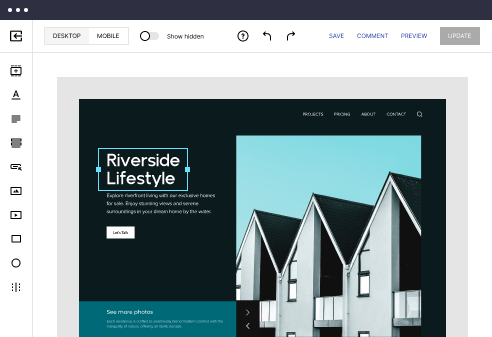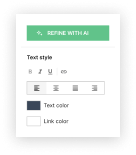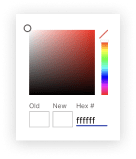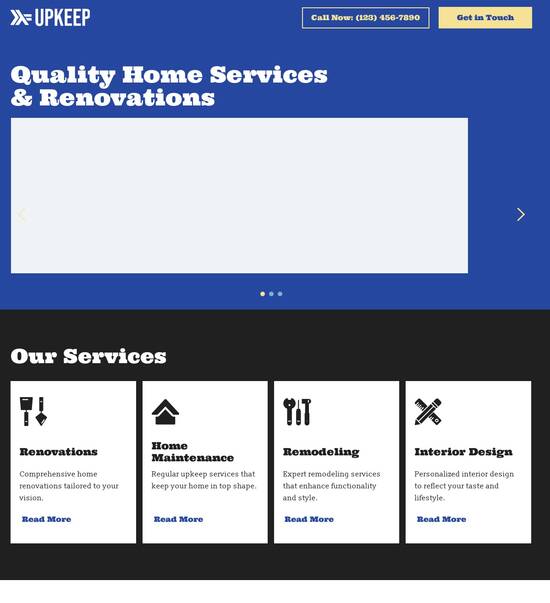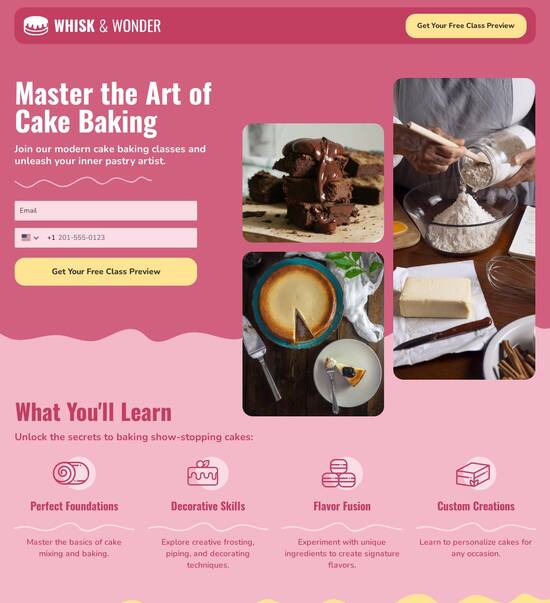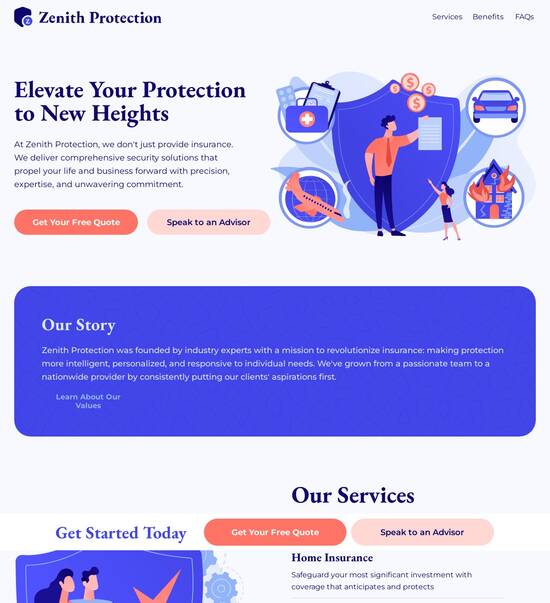
HTML/CSS optimized profile page template
Explore Similar TemplatesAbout template
Supercharge your profile page with HTML/CSS for outstanding performance! Learn more today.
Recommended templates
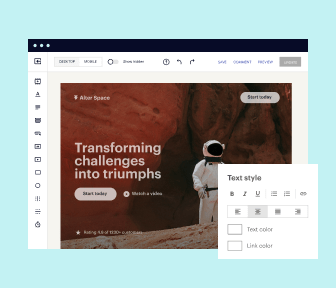
Easy to build without coding
With the intuitive drag-and-drop builder, anyone on your team can create high-converting pages without any knowledge of code or design. Make enhancements to your landing page with custom widgets using Javascript, HTML/CSS, or third-party scripts.
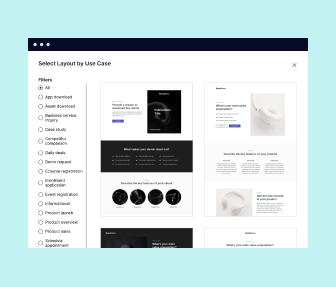
Multiple layouts for any industry and goal
Select from 500+ landing page layouts built to boost conversions across industry-specific scenarios. Customize them by adjusting fonts, adding images, and generating on-brand content with the AI assistant. Quickly scale with Instablocks® and Global Blocks that you can save, reuse, and update globally.
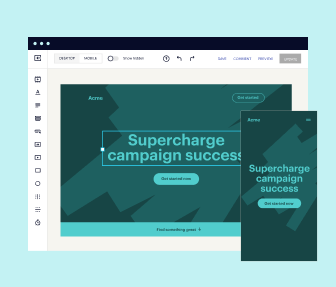
Loads fast and looks polished on any device
Every template is responsive, which means they present professionally on any device and load blazingly fast with our Thor Render Engine. You can also power them up with Google AMP technology to deliver an unparalleled mobile experience and drive higher conversions.
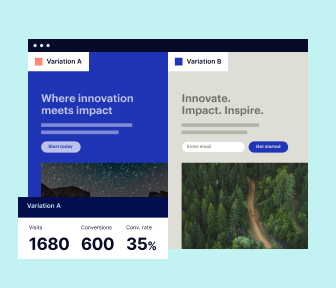
Robust analytics & experimentation
Get real-time updates and reporting across all your devices, showing the number of visitors, conversions, cost-per-visitor, and cost-per-lead. Launch AI-powered experiments, run A/B tests, and use heatmaps to analyze user behavior, then optimize your landing page to maximize conversions.
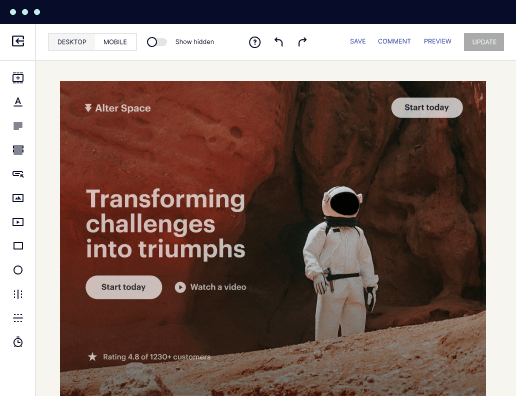
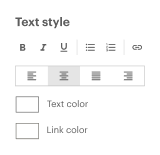
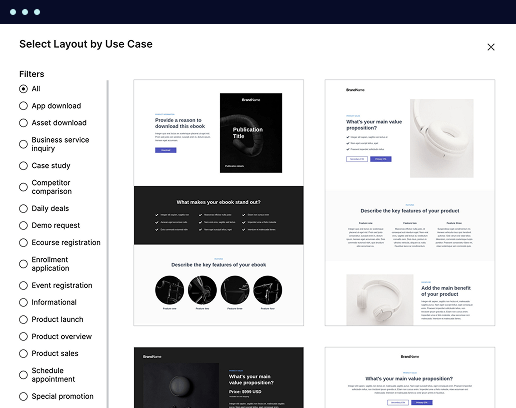
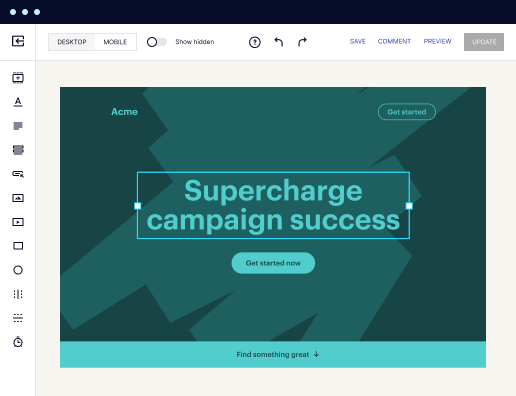
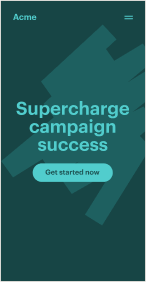
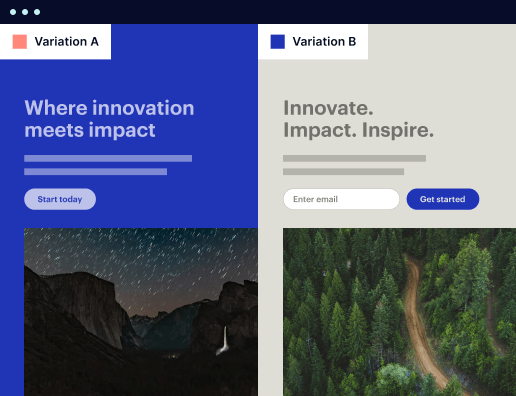
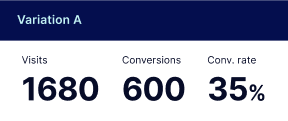
Easy to build without coding
With the intuitive drag-and-drop builder, anyone on your team can create high-converting pages without any knowledge of code or design. Make enhancements to your landing page with custom widgets using Javascript, HTML/CSS, or third-party scripts.
Multiple layouts for any industry and goal
Select from 500+ landing page layouts built to boost conversions across industry-specific scenarios. Customize them by adjusting fonts, adding images, and generating on-brand content with the AI assistant. Quickly scale with Instablocks® and Global Blocks that you can save, reuse, and update globally.
Loads fast and looks polished on any device
Every template is responsive, which means they present professionally on any device and load blazingly fast with our Thor Render Engine.
Robust analytics & experimentation
Get real-time updates and reporting across all your devices, showing the number of visitors, conversions, cost-per-visitor, and cost-per-lead. Launch AI-powered experiments, run A/B tests, and use heatmaps to analyze user behavior, then optimize your landing page to maximize conversions.
All the features you need to build html css profile page template
Explore more featuresLearn how to build profile page template html css
FAQs
Leading the way in building high-performing landing pages





A step-by-step guide to using Instapage for landing page optimization
Effective landing page optimization is crucial for marketers in various industries such as business services, tech, and education. Instapage stands out as a powerful platform that supports this process effortlessly. With a myriad of tools at your disposal, this guide will walk you through optimizing your landing pages to maximize your ROI and drive conversions.
Understanding the importance of landing page optimization
Landing page optimization (LPO) refers to the process of improving your web pages to increase the percentage of visitors who complete a desired action. This could include signing up for newsletters, making purchases, or submitting contact information. High-converting landing pages can significantly influence campaign success, especially in competitive verticals like financial services and education.
- Increased conversion rates: By refining landing pages based on audience behavior, you can enhance user experience and engagement.
- Better return on investment: Optimized landing pages yield higher ROI by ensuring that your marketing spend results in actionable leads.
- Tailored experiences: Instapage allows dynamic content delivery, meeting the specific needs of different audience segments.
Starting with Instapage's powerful templates
Begin your journey by exploring Instapage's extensive library of over 100 high-converting templates. These templates are designed for seamless integration into your marketing campaigns, providing a solid foundation for your landing pages.
- Choose templates based on industry: Whether you’re in tech or education, select templates tailored for your sector.
- Utilize pre-built lead generation elements: Each template includes integrated lead capture forms to enhance conversion opportunities.
- Leverage intuitive builders: Instapage's drag-and-drop builder makes it easy to customize templates without the need for coding.
Optimizing your content for lead generation
Content is king, and this is especially true for landing pages. Your page's content should be tailored to resonate deeply with your audience. This involves a combination of personalized messaging and strategic use of keywords.
- Incorporate dynamic text replacement: This feature allows you to personalize headlines and content based on user data.
- Employ A/B testing: Use Instapage’s built-in experimentation features to test different content variants for effectiveness.
- Analyze heatmap data: Understand user interactions with your page to identify areas for improvement.
By following these steps, you can create landing pages that not only attract visitors but also guide them towards conversion. Instapage equips you with all the tools you need to succeed.
Getting started with landing page optimization can feel overwhelming, but with Instapage, you have the resources to streamline this process and maximize success.
Ready to elevate your digital marketing strategy? Try Instapage today and transform your landing page experience!
People also ask about HTML/CSS optimized profile page template
Creating an HTML/CSS Optimized Profile Page Template
Overview of HTML/CSS profile page templates
HTML/CSS profile page templates are pre-designed layouts intended to display user profiles on websites or applications. They serve as a foundational structure, allowing individuals or organizations to present key information such as photos, personal details, skills, and accomplishments. The primary purpose is to create an attractive and user-friendly interface that fosters engagement and information sharing.
Optimization in profile page design is crucial. It ensures that these templates load quickly, are visually appealing, and function well across all devices. An optimized profile page significantly improves user experience, retention, and even convert visitors into active users. By addressing the needs of both the user interface and user experience, web developers can create pages that stand out.
Definition and purpose: Profile page templates are designed to organize and display user information clearly.
Importance of optimization: Faster loading and better usability lead to enhanced user engagement.
Target audience: These templates cater to everyone from beginners to advanced web developers.
Understanding HTML and CSS fundamentals
HTML, or HyperText Markup Language, is the backbone of web development, laying the groundwork for all web pages. It employs various elements and tags to structure the content. Each tag serves a specific purpose, such as defining headings, paragraphs, links, and images. Understanding the fundamentals of HTML is imperative for anyone looking to create a profile page template, as it helps in organizing the content effectively.
Semantic HTML plays a significant role in web page accessibility and SEO. By using appropriate tags that clearly define the structure and purpose of content, developers can enhance the page's visibility in search engines while ensuring that assistive technologies can interpret the content correctly. Best practices include using descriptive tags like , , , and .
CSS, or Cascading Style Sheets, complements HTML by providing styling and layout capabilities. It enhances the visual appeal of HTML elements, allowing developers to control colors, fonts, spacing, and overall aesthetics. The beauty of CSS lies in its ability to create responsive designs, meaning that profiles look great on desktops, tablets, and smartphones. Techniques such as media queries and Flexbox help achieve this adaptability.
Features of an optimized profile page template
User-centric design principles are at the core of effective profile page templates. These principles ensure that users enjoy an intuitive and straightforward navigation experience. Key considerations include accessibility for users with disabilities and ensuring that the interface encourages interaction, engagement, and user satisfaction. Building templates that accommodate diverse audiences can significantly boost user adoption.
Flexible and adaptive layouts further enhance the user experience. The use of grid systems helps organize content into visually digestible sections, allowing users to find information with ease. When deciding between fluid versus fixed designs, it’s essential to weigh the advantages of adaptability against potential layout constraints. Fluid designs provide more flexibility, especially across various device sizes.
Profile picture upload and display features are essential for personalization.
A user bio section allows individuals to showcase their personality.
Dynamic content blocks, such as skills and project showcases, highlight user expertise.
Optimization techniques for profile pages
Performance optimization is vital for keeping users engaged. Minimizing load times can be achieved by ensuring the HTML and CSS are lightweight. This involves avoiding unnecessary code, which can slow down rendering times. Image optimization is also essential, where using the appropriate formats, compressing images, and ensuring responsive behavior contribute significantly to performance improvements.
Search Engine Optimization (SEO) practices can enhance visibility for profile pages. Incorporating relevant meta tags and keywords within the HTML structure allows search engines to index the pages effectively. Structured data, or schema markup, can further improve discovery by providing additional information to search engines regarding the content of the profile page, resulting in better search results.
Cross-browser compatibility ensures that profile pages function correctly across various browsers. Developers should leverage testing tools to identify issues and standardize rendering. Prioritizing this aspect will help guarantee that all users enjoy a consistent experience, regardless of their browser choice.
Benefits of using an HTML/CSS optimized profile page template
Using an optimized profile page template can attract a diverse range of user groups. For beginners, templates often come with simple setup instructions and accompanying tutorials to aid the learning process. These templates can also incorporate advanced features appealing to professional users, creating a duality that serves all potential audiences.
Optimized profile pages enhance personal branding opportunities, allowing users to showcase their skills and experiences effectively. A well-designed template projects professionalism, helping users build credibility and trust with their audience. Moreover, having the versatility to update or modify a profile easily ensures that the template remains relevant.
Scalability features ensure that templates can grow with users' needs.
Modular layout components permit easy customization and reuse.
Integration capabilities with other services expand the functionality of profile pages.
Practical steps to create your own profile page template
Setting up your development environment is the first step toward creating a profile page template. A code editor, like Visual Studio Code or Sublime Text, is essential for coding practices. Additional tools like Chrome Developer Tools can assist in debugging and testing, while learning JavaScript can enhance functionality beyond HTML and CSS.
Creating the basic structure with HTML involves crafting a skeleton layout where various elements will reside. A sample code snippet might include essential tags like , , , along with sections for headers and footers. Ensuring the code is clean, well-commented, and maintainable is paramount, as this aids collaboration and future updates.
Once HTML is established, styling the profile page with CSS is the next logical step. Applying styles using a sample code snippet can personalize the look of the page. Employing techniques like CSS variables for theme selection can facilitate easy customization of color schemes and fonts, ensuring consistency throughout the profile.
Testing your profile page is as crucial as the design and coding phases. Gather feedback through user testing to discover real limitations or issues faced by users. Implementing A/B testing strategies can help identify which features resonate better with the audience, ensuring the final template is user-focused.
Resources and tutorials for further learning
For those looking to expand their understanding of HTML and CSS, comprehensive learning platforms like Coursera and Udemy offer a variety of online courses focused on these topics. These courses range from beginner to advanced levels, helping users refine their skills at their own pace.
In addition to courses, coding communities and forums, such as Stack Overflow or GitHub, provide peer support where developers can share insights, troubleshoot challenges, and collaborate on projects. Engaging in these communities fosters learning through shared expertise.
HTML and CSS references by W3C are useful for understanding standards.
Frameworks and libraries like Bootstrap or Tailwind CSS can further enhance template capabilities.
Analyzing successful profile pages helps identify elements to emulate in your designs.
Future trends in profile page design
Innovations in user experience (UX) are set to redefine profile page design. The incorporation of Artificial Intelligence (AI) for personalizing user profiles is gaining traction, offering tailored content recommendations that adapt to user behavior. As technology evolves, trends like minimalism and dark mode are becoming essential to meet user aesthetic preferences.
Developers should also be aware of new skills and tools that emerge as industry standards evolve. For instance, newer coding languages can simplify various aspects of web development, making it easier to create sophisticated templates. As we look toward the future, we can anticipate more integration with emerging technologies like Virtual Reality (VR) and Augmented Reality (AR), paving the way for interactive profile pages.
Summary of key takeaways
Using optimized HTML/CSS profile page templates can play a significant role in engaging your audience effectively. By focusing on skillful design and coding practices, web developers can transform simple profiles into compelling digital experiences. The intersection of performance optimization, SEO strategies, and user-centric design sets the stage for the future of online profiles.
As the demand for personal branding grows, individuals can utilize these templates to establish credibility, showcase expertise, and connect with broader user communities. Embracing the principles discussed above will not only aid in creating visually appealing profiles but also contribute to overall online success.
Ready to skyrocket conversions?
Supercharge your ad campaigns with high-performing landing pages
Get started